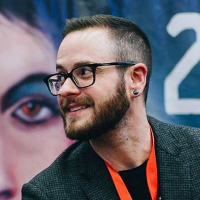
Cáel M. Keegan
2021-22 Fulbright Distinguished Research Chair of Arts and Social Sciences at Carleton University
| Degrees: | PhD (University at Buffalo) |
| Email: | keeganc@gvsu.edu |
| Office: | Grand Valley State University, Allendale, Michigan, USA |
| Website: | Browse |
Cáel M. Keegan is a cultural theorist of transgender/queer media and literature. He is primarily interested in the aesthetic forms transgender and queer people have created and how those forms shape our popular lifeworlds. Keegan is the 2021-22 Fulbright Distinguished Research Chair of Arts and Social Sciences at Carleton University and Associate Professor of Women, Gender, and Sexuality Studies at Grand Valley State University. He is author of Lana and Lilly Wachowski: Sensing Transgender (University of Illinois Press, 2018) and co-editor of Somatechnics 8.1 on trans cinematic bodies. His writing has also appeared in Genders, Queer Studies in Media and Popular Culture, Transgender Studies Quarterly, Mediekultur, The Journal of Homosexuality, The Journal of Cinema and Media Studies, and FLOW. Currently, he serves as Special Editor for Arts and Culture at Transgender Studies Quarterly.
Keegan’s book, Lana and Lilly Wachowski: Sensing Transgender (University of Illinois Press, 2018) is the first academic analysis of the world’s most influential transgender media producers, the Wachowski sisters. Arguing that the Wachowskis’ careers have been co-constitutive with the historical appearance of transgender, the book traces how their cinema invents a trans aesthetics of the senses that has progressively disrupted conventional schemas of race, gender, space, and time. Offering compelling new readings of the Wachowskis’ visual works from Bound (1996) to Sense8 (2015-18), the project presents an aesthetic record of transgender across twenty years of media history. Keegan is now at work on a second book project on “bad” trans media objects and their cultural and political value.
Books:
Lana and Lilly Wachowski: Sensing Transgender. Urbana: University of Illinois Press, 2018.
Edited Volumes:
Somatechnics. Special Issue: “Cinematic Bodies.” Co-edited with Laura Horak and Eliza Steinbock. Vol. 8.1 (March 2018).
Recent Peer-Reviewed Articles:
2020 “Against Queer Theory.” Transgender Studies Quarterly 7.3 (August 2020): 349-53.
2018 “Getting Disciplined: What’s Trans* About Queer Studies Now?” Journal of Homosexuality 67.3: 384-397.
2017 “History, Disrupted: The Aesthetic Gentrification of Queer and Trans Cinema After the Recession.” Social Alternatives 35.3 (Spring 2017): 50-6.
2016 “Revisitation: A Trans Phenomenology of the Media Image.” MedieKultur 61.1-5 (Fall 2016): 26-41
2016 “On Being the Object of Compromise.” Transgender Studies Quarterly 3.1-2 (Spring 2016): 150-7.
2016 “Emptying the Future: Queer Melodramatics and Negative Utopia on Buffy the Vampire Slayer.” Queer Studies in Media and Popular Culture 1.1. (Jan. 2016): 9-22.
Recent Peer Reviewed Book Chapters:
In Press
“Mirror Scene: Transgender Aesthetics in The Matrix and Boys Don’t Cry.” In The Oxford Handbook of Queer Cinema. Eds. Ronald Gregg and Amy Villarejo (Oxford: Oxford UP).
Published
2021 “Revisiting the Cluster.” In Sense8: Transcending Television. Eds. Rob Stone and Deborah Shaw (New York: Bloomsbury Academic, 2021), 219-26.
2020 “Transgender Studies, or How to Do Things with Trans*.” In The Cambridge Companion to Queer Studies. Ed. Siobhan B. Somerville (Cambridge: Cambridge University Press, 2020), 66-78.
2017 “Nothing to Hide: Selfies, Sex, and the Visibility Dilemma in Trans Male Online Cultures.” Co-authored with T. Raun. In Sex in the Digital Age. Eds. Paul G. Nixon and Isabel K. Dusterhoft (New York: Routledge, 2017), 89-100.